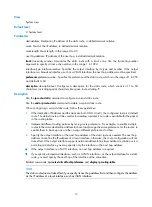
13
Description
Use the
display ipv6 routing-table
ipv6-address1 ipv6-address2
command to display routes with
destinations falling into the specified IPv6 address range.
Examples
# Display routes with destinations falling into the IPv6 address range.
<Sysname> display ipv6 routing-table 100:: 64 300:: 64
Routing Table :
Summary Count : 3
Destination: 100::/64 Protocol : Static
NextHop : :: Preference: 60
Interface : NULL0 Cost : 0
Destination: 200::/64 Protocol : Static
NextHop : :: Preference: 60
Interface : NULL0 Cost : 0
Destination: 300::/64 Protocol : Static
NextHop : :: Preference: 60
Interface : NULL0 Cost : 0
See
for description of the output.
display ipv6 routing-table protocol
Syntax
display ipv6 routing-table
protocol
protocol
[
inactive
|
verbose
] [
|
{
begin
|
exclude
|
include
}
regular-expression
]
View
Any view
Default level
1: Monitor level
Parameters
protocol
: Displays routes of a routing protocol, which can be
direct
and
static
.
inactive
: Displays only inactive routes. Without the keyword, all active and inactive routes are displayed.
verbose
: Displays both active and inactive verbose routing information. Without this keyword, only brief
active routing information is displayed.
|
: Filters command output by specifying a regular expression. For more information about regular
expressions, see the
Fundamentals Configuration Guide
.
begin
: Displays the first line that matches the specified regular expression and all lines that follow.
exclude
: Displays all lines that do not match the specified regular expression.
include
: Displays all lines that match the specified regular expression.
regular-expression: Specifies a regular expression, which is a case sensitive string of 1 to 256 characters.











































